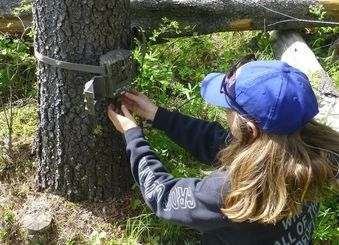Content by Michael Havrda, edited by Apryle Craig
An increasing number of researchers are using trail cameras as a non-invasive method to study wildlife. Trail cameras are easily deployed by citizen scientists and collect data round-the-clock, giving them an edge on direct observation studies. It's easy to end up with thousands of photos, but don't be overwhelmed. Here are a few tips to organize and analyze your trail camera photos:
An increasing number of researchers are using trail cameras as a non-invasive method to study wildlife. Trail cameras are easily deployed by citizen scientists and collect data round-the-clock, giving them an edge on direct observation studies. It's easy to end up with thousands of photos, but don't be overwhelmed. Here are a few tips to organize and analyze your trail camera photos:

- Record detailed site data: Keep track of how long cameras were deployed, GPS coordinates for them, and any site covariates you may want later (I keep all of this in an Excel sheet) - things such as deployment duration are critical for occupancy analysis, etc. Here is a basic datasheet for trail cameras.
- Get organized: Save the photos into separate folders for each deployment (i.e. CameraSite1, CameraSite2, etc.). I name my folders after whatever sample unit the camera was in.
- Never delete ANY photos, even if they're blanks/misfires, etc. You can always exclude them from analysis later, but always keep the data in its rawest form.
- Back up your data: Save them to your computer, an external hard drive, a second external hard drive, a cloud, a second cloud...okay, mainly joking here, but build redundancy into your system! The worst thing that can happen is you only save your data to one place. I personally save them to my laptop, a personal external drive, and an external drive I keep at UW. My techs also usually download the photos from the cameras they manage onto their own computers.
- Choosing software: There are lots of programs you can download onto your computer to catalog your photos (note that usually you'll need a second software program for analysis, such as R). I use eMammal which is not free. Carolyn uses CPW Photo Warehouse (which is free) and works great. There is also a newer R package (CamTrapR) but I have no experience with it.
- Auto-ID or image recognition? Currently, there are no packages that can look through the photos and ID animals This is something a lot of people would love, and some of the technology is in the works, but as far as we know, nothing has been released yet.
- Think ahead before you commit: Have an idea of what type of analysis you want to do and what program you're going to use before you start cataloging and organizing photos - sometimes different analysis types (or programs) want the data in different formats.
Do you have any additional tips? Feel free to email them to Apryle at uw [dot] edu and I will review them and add them as time permits.

 RSS Feed
RSS Feed